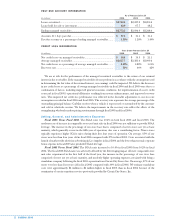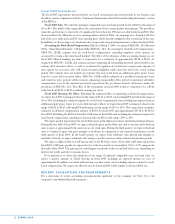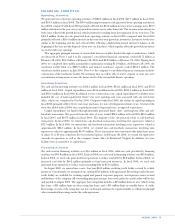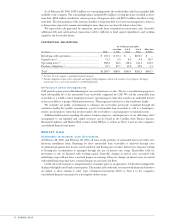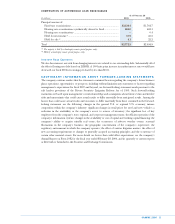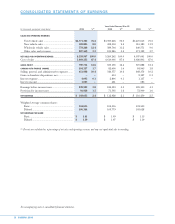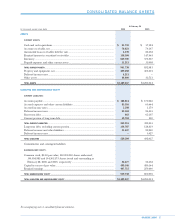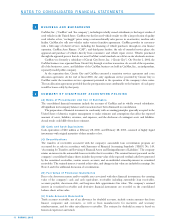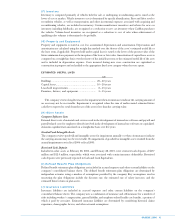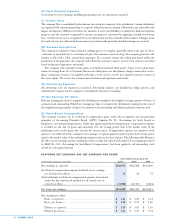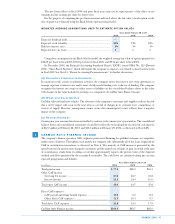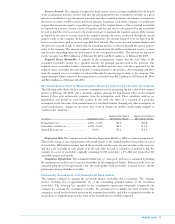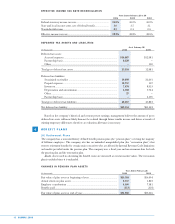CarMax 2006 Annual Report Download - page 42
Download and view the complete annual report
Please find page 42 of the 2006 CarMax annual report below. You can navigate through the pages in the report by either clicking on the pages listed below, or by using the keyword search tool below to find specific information within the annual report.
40
CARMAX 2006
BUSINESS AND BACKGROUND
CarMax, Inc. (“CarMax” and “the company”), including its wholly owned subsidiaries, is the largest retailer of
used vehicles in the United States. CarMax was the first used vehicle retailer to offer a large selection of quality
used vehicles at low, “no-haggle” prices using a customer-friendly sales process in an attractive, modern sales
facility. CarMax also sells new vehicles under various franchise agreements. CarMax provides its customers
with a full range of related services, including the financing of vehicle purchases through its own finance
operation, CarMax Auto Finance (“CAF”), and third-party lenders; the sale of extended service plans; the
appraisal and purchase of vehicles directly from consumers; and vehicle repair service. Vehicles purchased
through the appraisal process that do not meet CarMax’s retail standards are sold at on-site wholesale auctions.
CarMax was formerly a subsidiary of Circuit City Stores, Inc. (“Circuit City”). On October 1, 2002, the
CarMax business was separated from Circuit City through a tax-free transaction. As a result of the separation,
all of the businesses, assets, and liabilities of the CarMax business are held in CarMax, Inc., an independent,
separately traded public company.
At the separation date, Circuit City and CarMax executed a transition services agreement and a tax
allocation agreement. At the end of fiscal 2006, the only significant service provided by Circuit City to
CarMax under the transition services agreement pertained to the operation of the company’s data center.
The tax allocation agreement provided that the preseparation taxes attributable to the business of each party
would be borne solely by that party.
SUMMARY OF SIGNIFICANT ACCOUNTING POLICIES
(A) Basis of Presentation and Use of Estimates
The consolidated financial statements include the accounts of CarMax and its wholly owned subsidiaries.
All significant intercompany balances and transactions have been eliminated in consolidation.
The preparation of financial statements in conformity with accounting principles generally accepted in the
United States of America requires management to make estimates and assumptions that affect the reported
amounts of assets, liabilities, revenues, and expenses, and the disclosure of contingent assets and liabilities.
Actual results could differ from those estimates.
(B) Cash and Cash Equivalents
Cash equivalents of $6.0 million at February 28, 2006, and February 28, 2005, consisted of highly liquid
investments with original maturities of three months or less.
(C) Securitizations
The transfers of receivables associated with the company’s automobile loan securitization program are
accounted for as sales in accordance with Statement of Financial Accounting Standards (“SFAS”) No. 140,
“Accounting for Transfers and Servicing of Financial Assets and Extinguishments of Liabilities.” The company
retains an interest in the automobile loan receivables that it securitizes. The retained interest presented on the
company’s consolidated balance sheets includes the present value of the expected residual cash flows generated
by the securitized receivables, various reserve accounts, and an undivided ownership interest in securitized
receivables. The retained interest is carried at fair value, and changes in fair value are included in earnings. See
Notes 3 and 4 for additional discussion of securitizations.
(D) Fair Value of Financial Instruments
Due to the short-term nature and/or variable rates associated with these financial instruments, the carrying
value of the company’s cash and cash equivalents, receivables including automobile loan receivables,
accounts payable, short-term debt, and long-term debt approximates fair value. The company’s retained
interest in securitized receivables and derivative financial instruments are recorded on the consolidated
balance sheets at fair value.
(E) Trade Accounts Receivable
Trade accounts receivable, net of an allowance for doubtful accounts, include certain amounts due from
finance companies and customers, as well as from manufacturers for incentives and warranty
reimbursements, and for other miscellaneous receivables. The estimate for doubtful accounts is based on
historical experience and trends.
NOTES TO CONSOLIDATED FINANCIAL STATEMENTS
1
2


